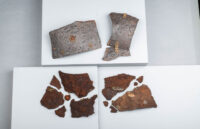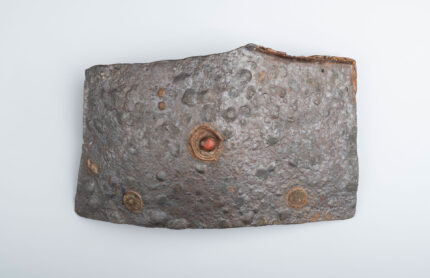Skip to comments.
Oldest Roman body armour found in Germany
The History Blog ^
| September, 2020
Posted on 10/24/2020 2:34:48 PM PDT by LibWhacker
Oldest Roman body armour found in Germany
 Archaeologists have discovered the oldest and most complete Roman body armour at the site of the Battle of the Teutoburg Forest in Kalkriese, Germany. Before this find, the earliest known examples of Roman lorica segmentata — iron plate sections tied together — were found in Corbridge, UK, and date to the 2nd century. Those were fragments. The Kalkriese armor is a complete set, and includes an extremely rare iron collar used to shackle prisoners.
Archaeologists have discovered the oldest and most complete Roman body armour at the site of the Battle of the Teutoburg Forest in Kalkriese, Germany. Before this find, the earliest known examples of Roman lorica segmentata — iron plate sections tied together — were found in Corbridge, UK, and date to the 2nd century. Those were fragments. The Kalkriese armor is a complete set, and includes an extremely rare iron collar used to shackle prisoners.
More than 7,000 objects have been found at the Kalkriese battlefield site, from weapons to coins to items of everyday use. In the summer of 2018, a metal detector scan of the side wall of an excavation trench retuned 10 strong signals, indications of a large quantity of metal inside the bank. To ensure whatever was in there wasn’t exposed to the air and rapid oxidization, archaeologists removed the entire soil block containing the mystery metallics.
The first step was to scan the block to see what was inside and map out its excavation. The block was too big for regular X-ray machines, so they transported the crate to the Münster Osnabrück International Airport where the customs office has a freight-sized X-ray machine. All they could see was nails of the wooden crate and a large black hole in the shape of the soil block.
In 2019, it was sent to the Fraunhofer Institute in Fürth which has the world’s largest CT scanner — a circular platform more than 11 feet in diameter that rotates while the X-ray apparatus moves up and down — more than big enough for the crate to fit and powerful enough to see inside the dense soil block. The scan revealed the remains of a cuirass — the section of a lorica segmentata where the breastplate and back plate are buckled together. The plates of the armour were pushed together like an accordion by the weight of the soil pressing on down them for 2,000 years.
Here’s a nifty digital animation by the Fraunhofer Institute generated from the CT scan data that reveals the armour inside the soil block.
 Armed with the detailed scans, restorers were able to begin excavation of the soil block. They found that despite Kalkriese’s highly acidic sandy soil, the armour is relatively well-preserved. There is extensive corrosion of the mental, but the set is uniquely complete with hinges, buckles, bronze bosses and even extremely rare surviving pieces of the leather ties. The plates from the shoulder and chest have been recovered and restored. The belly plates are still in the soil block. There are no arm plates in this early design.
Armed with the detailed scans, restorers were able to begin excavation of the soil block. They found that despite Kalkriese’s highly acidic sandy soil, the armour is relatively well-preserved. There is extensive corrosion of the mental, but the set is uniquely complete with hinges, buckles, bronze bosses and even extremely rare surviving pieces of the leather ties. The plates from the shoulder and chest have been recovered and restored. The belly plates are still in the soil block. There are no arm plates in this early design.
 Iron plate armour was introduced by Augustus as an improvement on chain mail. It was relatively light (around 17 pounds) and because the plates were tied together with leather cords, they were much more flexible than chain mail. so it was the latest and greatest technology in 9 A.D. when Publius Quinctilius Varus blundered into a German ambush that obliterated three full Roman legions plus their auxiliaries.
Iron plate armour was introduced by Augustus as an improvement on chain mail. It was relatively light (around 17 pounds) and because the plates were tied together with leather cords, they were much more flexible than chain mail. so it was the latest and greatest technology in 9 A.D. when Publius Quinctilius Varus blundered into a German ambush that obliterated three full Roman legions plus their auxiliaries.
The legionary who wore this armour apparently survived the battle because around his neck/shoulder area was a shrew’s fiddle, also known as a neck violin. This was an iron collar connected to two handcuffs that locked a prisoner’s hands in front of his neck. The Romans used them to shackle prisoners destined for slavery. This time the tables were turned, and the soldier died in shackles.
The restoration is ongoing and is expected to take another two years. Once it’s complete, the armour will go on display in an exhibition at the Kalkriese Museum and Park.

TOPICS: History; Military/Veterans; Science
KEYWORDS: armor; germany; godsgravesglyphs; kalkriese; oldest; romanbaltic; romanempire; romangermany; rome; teutoberg; teutobergforest; teutoburg
Navigation: use the links below to view more comments.
first previous 1-20, 21-40, 41-50 last
The rest of the RomanBaltic keyword:
- Farmer Finds Roman Treasure Trove Scattered Across Field [Poland] [2020]
- Restorers discover shield fragment is 1,700 years old, making it the oldest German panel painting [2019]
- 1,800 Year Old Roman Inscription on Milestone East of the Kinneret Deciphered [2019]
- Thousands of objects discovered in Scandinavia's first Viking city [2018]
- This Golden Head Adds a Twist to Ancient Roman History [Waldgirmes, Germany] [2018]
- 'Spectacular' ancient public library discovered in Germany [2018]
- Bone trove in Denmark tells story of 'Barbarian' battle [2018]
- Archaeologist: We have evidence of the presence of Roman legionaries in Poland [2018]
- Archaeologists discover 'Roman Village' in Gernsheim [2015]
- Roman drunkard found on Danish island [2015]
- Village from the Roman period discovered in the Carpathians [2014]
- Hitting the jackpot on a dig in Gernsheim: Long lost Roman fort discovered [2014]
- Migration Period cremations unearthed in Poland [2014]
- Ancient Roman Military Camp Unearthed in Eastern Germany [2014]
- A Roman hoard from the end of empire [2014]
- New Iron Age Sites Discovered in Finland [Roman era] [2014]
- Treasure trove reveals Iron Age town [Sweden] [2013]
- German battlefield yields Roman surprises [2013]
- Roman military camp dating back to the conquest of Gaul throws light on a part of world history [2012]
- Two Iron Age Sites Discovered in Finland [2012]
- An Army Sacrificed in a Bog [ Alken, Denmark, 2K ago ] [2012]
- Students find rare Roman temple on practice dig [Poppelsdorf, Germany] [2012]
- Lost Roman camp that protected against Germanic hordes found [2011]
- New finds suggest Romans won big North Germany battle [ Maximinus Thrax ] [2010]
- Near Army construction site in Germany, a trove of ancient Roman artifacts [2009]
- 2,000-year-old statue of Emperor Augustus on horseback found in stream [2009]
- Gold-plated Roman horse head found (near Frankfurt) [2009]
- Ancient Roman battlefield excavated in Lower Saxony[Germany] [2008]
- Triumph of the Polish will [2007]
- Report: Ancient Roman graveyard found in suburban Copenhagen [2007]
- Crystal Amulet Poses Question On Early Christianity (Denmark - 100AD) [2007]
- Graves Hint At Contact With Romans (Sweden) [2006]
- Gibbon on global warming [2006]
- Buddha statue from 6th c found in Viking hoard in Helgo, Sweden [2005]
- The Romans in Ireland [2004]
41
posted on
10/24/2020 10:47:57 PM PDT
by
SunkenCiv
(Imagine an imaginary menagerie manager imagining managing an imaginary menagerie.)
To: SunkenCiv
You get the pings, the armor has the dings.
To: Redcitizen
If they keep up their vigil, they may find a strigel..
43
posted on
10/24/2020 11:53:16 PM PDT
by
SunkenCiv
(Imagine an imaginary menagerie manager imagining managing an imaginary menagerie.)
To: SunkenCiv
So the (Roman) Emperor needs new clothes, eh?
Very nice! Thanks!
;o]
‘Face
44
posted on
10/25/2020 12:40:02 AM PDT
by
Monkey Face
("When tyranny becomes law, rebellion becomes duty." ~~ Thomas Jefferson ~~)
To: Monkey Face
45
posted on
10/25/2020 12:44:39 AM PDT
by
SunkenCiv
(Imagine an imaginary menagerie manager imagining managing an imaginary menagerie.)
To: SunkenCiv; LibWhacker
Very interesting.
As an aside, am curious whatthe Fraunhofer Institute in Fürth uses the the world’s largest CT scanner for.
46
posted on
10/25/2020 8:28:57 AM PDT
by
BenLurkin
(The above is not a statement of fact. It is either opinion or satire. Or both.)
To: BenLurkin
Inasmuch as I was stationed 15 klicks north of there for a couple of years, this immediately perked my interest. Apart from being Henry Kissinger's hometown and the location of the best wienerschnitzel restaurant in the whole world, there's not much around there.
Anyway, "CT Scanner: Taking a close look, whatever the scale".
Sehr interessant, thx!
To: BenLurkin
CT Scanner: Taking a close look, whatever the scale
Fraunhofer Institute for Integrated Circuits (IIS)186, Fürth, Germany
Research News Oct 01, 2013 — Researchers at the Fraunhofer Development Center X-ray Technology work with the biggest and smallest computed tomography scanners in the world – equipment that is able to scan everything from entire shipping containers to tiny biological samples.
Through the eye of the XXL CT scanner: A car reveals its innermost secrets at the Fraunhofer Development Center for X-ray Technology EZRT in Fürth. © Fraunhofer IIS
Following the 50 km/h crash test, all that was left of the car was a heap of metal – one that contains valuable information on how vehicle safety could be improved. But the only way engineers can get at this information is if they can see inside the vehicle to analyze how its individual components reacted to the force of the impact. The typical two-dimensional X-ray images used in conventional materials testing are often not accurate enough, as what they show is no more than a kind of shadow-picture taken from a single angle. Computed tomography (CT) offers researchers many more possibilities for examining components: By recording parts in all three dimensions, it allows them to be measured and inspected in a contact-free and non-destructive way. But how do you fit an entire car into a CT scanner?
XXL CT scanner developed for shipping containers
Scientists at the Fraunhofer Institute for Integrated Circuits IIS have the answer. They have developed a huge CT scanner that will in future scan cars, airplane wings and even entire shipping containers. It works as follows: First, the object to be examined is hoisted onto a giant turntable. As it turns, an X-ray source on one side of the object moves up and down, and these movements are mirrored by a four-meter-long X-ray detector on the other. The readings are sent to a computer, which then generates a three-dimensional image. “We have never been able to carry out non-destructive materials testing on this scale before,” says Professor Randolf Hanke, director of the Fraunhofer Development Center X-ray Technology EZRT. At the resolution the system currently achieves – which at 0.8 mm is already extremely high – scientists can make out even the tiniest of details with pin-sharp precision on objects that are several meters in size. Researchers hope soon to improve the resolution even further to 0.4 mm. Some of the potential uses for this technology include bringing prototypes of new cars into alignment with design data, or spotting material failures such as minuscule cracks in automotive or aircraft components. Security forces could use the giant scanner to detect explosives or other prohibited objects in shipping containers without having to open them.
CT machine heading for nanoscale scans
This giant piece of equipment has a counterpart that Prof. Hanke can comfortably carry around with him wherever he goes. No bigger than a microwave oven, and with a resolution of 0.02 mm, it can scan anything from the smallest plastic parts to biological samples. Now that they have developed what is currently the smallest portabel CT scanner in the world, Prof. Hanke and his team are already working on the next innovation: a device that will be able to push the limits of geometric magnification down to even higher resolutions. The aim is to be able to scan at nanoscale level, that is to say, at a magnitude of under 100 nanometers. This vision has been driving Prof. Hanke’s research for the last 15 years. He and his team of students and postgraduates at the Chair of X-ray Microscopy at the University of Würzburg recently enjoyed a significant breakthrough. “We’ve now succeeded in customizing an electron microscope in such a way that it is able to produce a nano X-ray source,” he explained. The clever part is that the electric charge carriers that generate the X-rays are conducted onto the side of a thin needle. The resulting X-rays emitted from the tip of this needle deliver a precise focal point 50 nm in diameter for scanning nanoscale objects in clearly defined detail. One thing this technology would allow biologists to do is to analyze the way water is transported within wood fibers.
In July of this year, the new EZRT building was officially opened in Fürth-Atzenhof, and Prof. Hanke is very pleased: “This new building, which will be home to our industrial computed tomography activities, allows us to pool our expertise to address problems at any scale in a wide range of fields. Our equipment and understanding of the process means we can scan everything from ancient works of art to entire wind turbines.”
To: LibWhacker
49
posted on
10/25/2020 10:28:12 AM PDT
by
BenLurkin
(The above is not a statement of fact. It is either opinion or satire. Or both.)
To: LibWhacker
If you treat your prisoners well then the enemy will hesitate less when the choice is surrender or death. If they know the will be treated well the that whole “fight to the death” deal becomes less likely.
50
posted on
10/25/2020 10:35:22 AM PDT
by
central_va
(I won't be reconstructed and I do not give a damn...)
Navigation: use the links below to view more comments.
first previous 1-20, 21-40, 41-50 last
Disclaimer:
Opinions posted on Free Republic are those of the individual
posters and do not necessarily represent the opinion of Free Republic or its
management. All materials posted herein are protected by copyright law and the
exemption for fair use of copyrighted works.
FreeRepublic.com is powered by software copyright 2000-2008 John Robinson
 Archaeologists have discovered the oldest and most complete Roman body armour at the site of the Battle of the Teutoburg Forest in Kalkriese, Germany. Before this find, the earliest known examples of Roman lorica segmentata — iron plate sections tied together — were found in Corbridge, UK, and date to the 2nd century. Those were fragments. The Kalkriese armor is a complete set, and includes an extremely rare iron collar used to shackle prisoners.
Archaeologists have discovered the oldest and most complete Roman body armour at the site of the Battle of the Teutoburg Forest in Kalkriese, Germany. Before this find, the earliest known examples of Roman lorica segmentata — iron plate sections tied together — were found in Corbridge, UK, and date to the 2nd century. Those were fragments. The Kalkriese armor is a complete set, and includes an extremely rare iron collar used to shackle prisoners.

